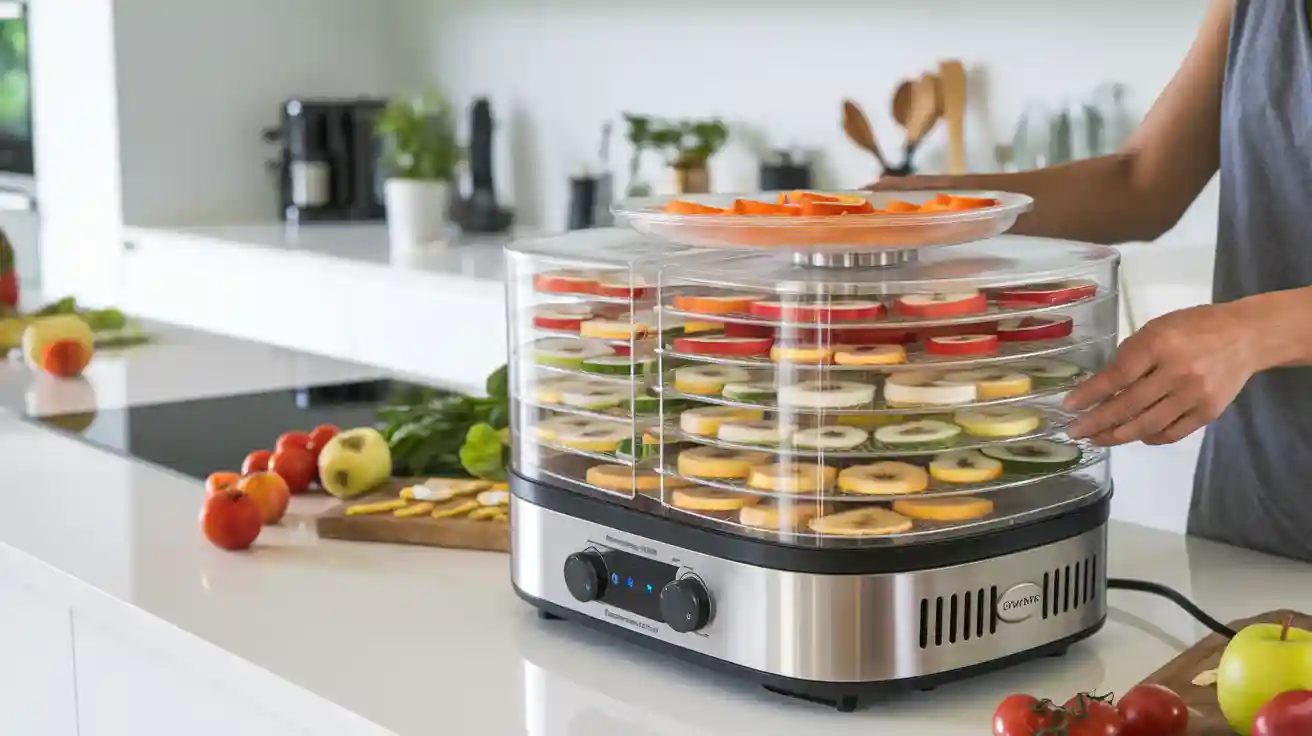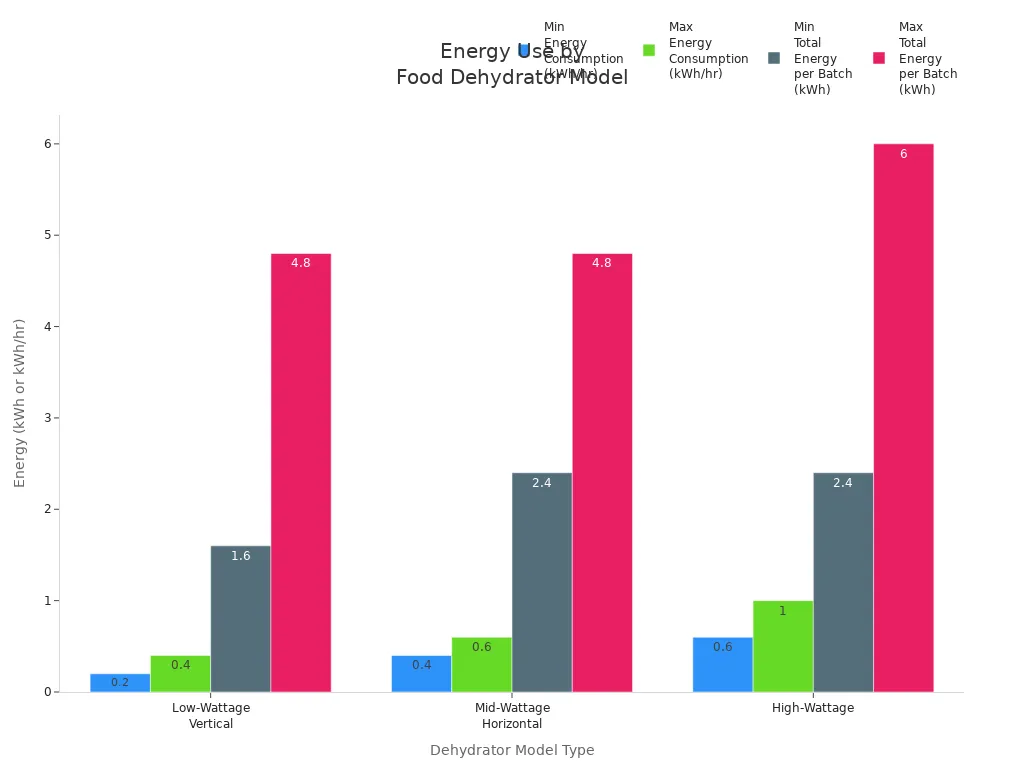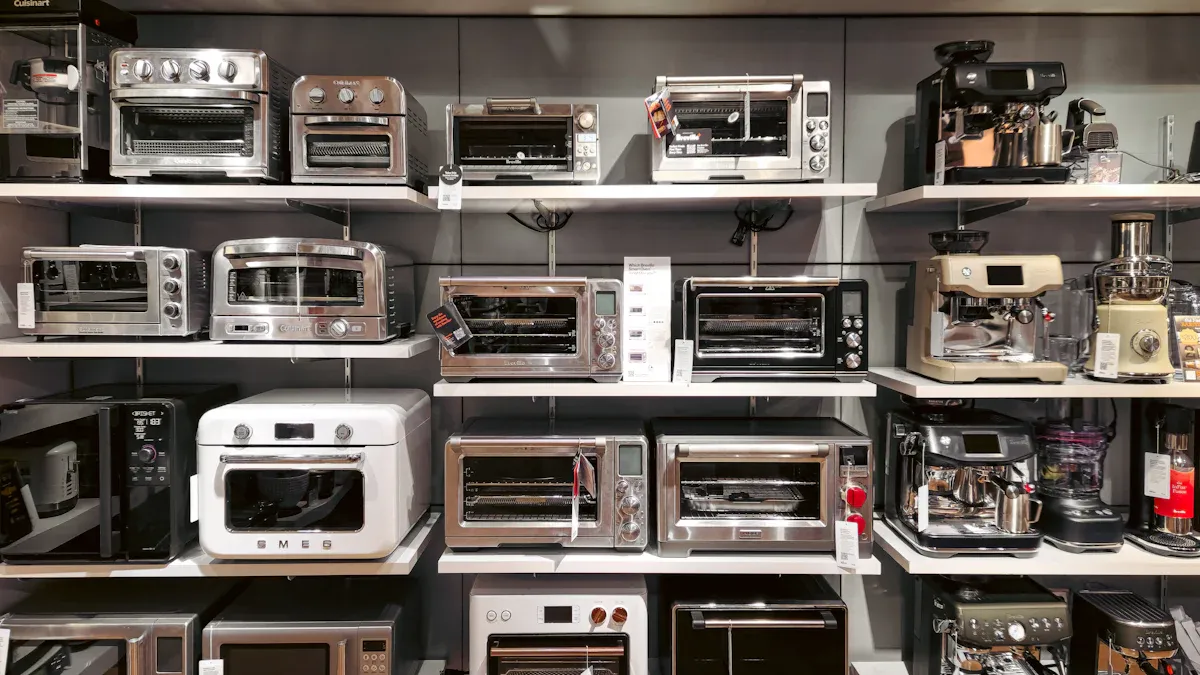
When you start buying a food dehydrator, think about your needs and drying goals. Many people choose a multi-tray dehydrator food dehydrator to handle large batches, dry different foods, and save money. You want a food dehydrator that matches your needs, fits your kitchen, and makes drying easy.
- Drying many foods at once saves time and reduces waste.
- Expandable trays and easy cleaning matter for busy kitchens.
- Dehydrator food dehydrator features like timers give you better control.
You should look at all the factors to consider before picking the right dehydrator for your needs.
Key Factors When Buying a Food Dehydrator for Your Needs
Capacity and Tray Number
When you start buying a food dehydrator, you want to match the drying capacity to your needs. If you plan to dry large batches or different foods at once, look for a dehydrator food dehydrator with multiple trays. More trays mean you can dry more food in one go, which saves time and energy. Here’s a quick look at typical tray capacities:
| Configuration | Number of Trays Range | Total Tray Area Range (sq. ft) |
|---|---|---|
| 1 Cart | 30 – 60 | 94 – 188 |
| 2 Carts | 60 – 120 | 188 – 375 |
| 4 Carts | 120 – 240 | N/A |
| 8 Carts | 240 – 480 | N/A |
| 10 Carts | 300 – 600 | N/A |
If you only need to dry snacks for your family, a smaller model with 4-6 trays works well. For big families or bulk food prep, you might want a larger model. Expandable trays give you flexibility as your drying goals change.
Tip: Stackable trays let you add more space as your needs grow, but make sure the motor can handle the extra load.
Airflow and Heat Distribution
Even airflow is one of the most important factors to consider when buying a food dehydrator. Good airflow ensures every tray dries food evenly, so you get high-quality dehydrated foods every time. Some dehydrators use horizontal airflow, which moves air across each tray, while others use vertical airflow from the bottom or top.
- Horizontal airflow models (like shelf-style dehydrators) give you more consistent results and less tray rotation.
- Vertical airflow models (stackable types) may need you to rotate trays for even drying, especially with multiple trays.
If you want to dry different foods at once, look for a model with advanced airflow design. This helps prevent flavor mixing and supports the food drying capabilities you need.
Temperature Control and Range
Temperature control is key for getting the best results from your food dehydrator. Different foods need different temperatures to dry safely and keep their nutritional value. Here’s a guide to recommended temperatures:
| Food Type | Recommended Temperature Range |
|---|---|
| Herbs, spices, mushrooms, cheese | 20–40°C (86–104°F) |
| Vegetables, berries, fruits, fruit leather, starchy foods | 52°C (125°F) |
| Cooked meat, fish, cooked rice | 68°C (155°F) |
Adjustable temperature control lets you set the right heat for fruits, veggies, or even dehydrating jerky. Most models offer a range from 100°F to 160°F, but premium models may go wider. This flexibility helps you preserve flavor and texture, and it keeps your food safe.
- Adjustable temperature control supports drying many types of food.
- Custom settings help you get the texture and taste you want.
- Lower temperatures keep more nutrients in your food.
Ease of Use and Cleaning
You want a food dehydrator that makes life easier, not harder. Look for features that help you use and clean your dehydrator quickly:
- Digital control panels with clear buttons
- Programmable timers and automatic shutoff
- Dishwasher-safe trays and drip trays
- Stackable or sliding trays for easy access
- Preset programs for common foods
Cleaning is simple if you follow a few steps. Wash trays with warm, soapy water after each use. Some trays are dishwasher safe, which saves time. Use soft sponges or brushes to reach corners. Avoid harsh chemicals to protect your food and the quality of construction.
| Cleaning Aspect | Recommended Method/Material | Purpose/Benefit |
|---|---|---|
| Frequency | Clean after each drying session or regularly to prevent residue buildup | Prevents hard-to-remove stains, contamination, and preserves food taste |
| Trays | Hand wash with warm soapy water; soak overnight for tough residue; some trays dishwasher safe (top rack) | Ensures thorough cleaning without damage; easier residue removal |
| Cleaning Tools | Soft sponge, Q-tips, toothbrush, spatula, canned air | Reach corners, rails, fan, and heating element without disassembly |
| Chemicals | Avoid harsh chemicals; use mild detergent and warm water | Prevents chemical residue that can contaminate food |
| Heating Element & Fan | Do not disassemble; clean exterior with soft cloth when unplugged and cool; keep bottom tray empty to catch drips | Avoids damage and malfunction; prevents residue buildup on critical parts |
| Preventive Measures | Use nonstick liners, parchment paper, or mesh screens; gently lift food after 1 hour drying | Reduces food sticking, eases cleaning, and prolongs dehydrator lifespan |
| Contamination Prevention | Regular cleaning prevents bacterial and fungal growth | Ensures food safety and quality |
Note: Using nonstick liners or mesh screens makes cleanup much easier and protects your trays.
Noise Level and Kitchen Fit
Noise level matters, especially if you plan to run your dehydrator food dehydrator overnight or in a busy kitchen. Most models run between 50 and 63 decibels, which is about as loud as a normal conversation. Some premium models are quieter, making them a better fit for open kitchens or apartments.
| Dehydrator Model | Noise Level (dB) | Notes |
|---|---|---|
| Heavybao 88 Tray Commercial Food Dehydrator | 50 – 55 | Quiet operation, suitable for home and commercial use |
| Excalibur Sliding-Tray Model | Up to 63 | Considered relatively quiet but not silent |
When buying a food dehydrator, also check the size. Compact models like the COSORI Premium Mini (13.9 x 11.3 x 8.9 inches) fit well on most countertops. Domestic models balance drying capacity with a small footprint, so they don’t take over your kitchen. If you have limited space, choose a model that matches your needs and fits your kitchen layout.
Price Range and Value
The price range for multi-tray food dehydrators in 2025 covers everything from budget to premium. Here’s a quick comparison:
| Model Name | Number of Trays | Price (2025) | Key Features / Notes |
|---|---|---|---|
| Presto Dehydro Food Dehydrator | Multi-tray | $54.99 | Budget-friendly, basic model, suitable for entry-level use |
| Cosori 6-Tray Food Dehydrator | 6 trays | $143.99 | Mid-range, digital controls, stainless steel trays, quiet operation, beginner-friendly |
| Excalibur Performance Series | 10 trays | $517.32 | High-end, large capacity (16 sq. ft.), advanced drying tech, LED display, stainless steel design |
Budget models work well for small batches and simple needs. Premium models offer more trays, better temperature control, and advanced features. When buying a food dehydrator, think about your needs, the quality of construction, and the value you get for your money.
| Feature / Aspect | Budget Models (e.g., Hamilton Beach 32100A, Nesco FD-75A) | Premium Models (e.g., Tribest Sedona Express, COSORI Premium) |
|---|---|---|
| Drying Space | Smaller drying space; fewer trays (e.g., 5 stackable trays) | Larger drying capacity; more trays (e.g., 6-9 trays, up to 11 sq ft) |
| Tray Material | Often plastic trays, sometimes less durable | BPA-free plastic or stainless steel trays, more durable |
| Temperature Control Range | Moderate range (e.g., 100°F to 160°F) | Wider range (e.g., 77°F to 167°F) |
| Airflow Technology | Continuous airflow, single fan | Advanced airflow (e.g., dual-fan technology) for even drying |
| Additional Features | Basic digital control panel, transparent lid | Digital control with timers, overheat protection, automatic shutoff, LED lights |
| Noise Levels | Generally louder, less optimized for quiet operation | Often quieter, better balance of performance and noise |
| Design and Build | Compact, affordable, functional | Stylish, professional-grade, more robust build |
| Performance | Reliable but slower drying, less consistent | Faster, more consistent drying, enhanced user convenience |
| Price | Lower price point | Higher price point |
Extra Features for the Best Food Dehydrator
The best food dehydrator models come packed with extra features that make drying easier and safer. Here are some of the most popular:
| Feature | Description | Examples / Notes |
|---|---|---|
| Fan | Ensures even drying; without a fan, drying is uneven and difficult for certain foods like fruit leather. | Present in Excalibur, Cosori, Nesco; absent in Ronco. |
| Adjustable Temperature Settings | Allows drying at different temperatures suited for various foods (meat, herbs, fruits, vegetables). | Excalibur, Cosori, Nesco Gardenmaster Pro: 105°F-165°F; some models like Nesco FD-37 lack this. |
| Timer with Automatic Shut-off | Enables setting drying time and automatic power off for convenience and better control. | Available in Excalibur, Cosori, Nesco Gardenmaster Pro; missing in some cheaper models. |
| Heating Element & Fan Location | Placement at top or back avoids malfunction from drippings; bottom-mounted can cause issues. | Excalibur and Cosori: back-mounted; Nesco mostly top-mounted except FD-1010 (bottom). |
| Expandability | Ability to add extra trays to increase capacity, though too many trays may affect drying consistency. | Nesco offers extra trays for purchase; Excalibur and Cosori have fixed tray capacities. |
| Tray Design | Sliding trays allow easy access and rotation for uniform drying; stacking trays require lifting layers. | Excalibur and Cosori have sliding trays; Nesco uses stacking trays. |
Timers and automatic shut-off features let you set and forget your dehydrator food dehydrator. You don’t have to watch the clock or worry about over-drying. These features also save energy and keep your food’s nutritional value high.
- Timers help you manage busy schedules and multiple batches.
- Automatic shut-off protects against overheating and keeps your kitchen safe.
- Expandable trays and sliding designs make it easy to adjust for different drying needs.

When you look at all the factors to consider, you’ll find that the right types of food dehydrators offer a mix of drying power, safety, and convenience. The benefits of food dehydrators include healthy snacks, less food waste, and extended shelf life for your favorite foods. With the right features, you can enjoy high-quality dehydrated foods at home, every time.
Comparing the Best Food Dehydrator Types and Brands

Stackable vs. Shelf-Style Dehydrator Food Dehydrator
When you look at different types of food dehydrators, you’ll notice two main styles: stackable and shelf-style. Each has its own strengths. Stackable food dehydrators let you add or remove trays, so you can adjust the size for your batch. You may need to rotate trays for even drying, but these models save space and cost less. Shelf-style dehydrators use horizontal airflow, which means you get even drying without moving trays. You can slide trays out easily, and these models work well for fruit leathers or thick foods. Here’s a quick table to help you compare:
| Feature | Stackable Dehydrators | Shelf-style Dehydrators |
|---|---|---|
| Airflow Design | Vertical, may need tray rotation | Horizontal, even drying |
| Capacity Flexibility | Expandable trays | Fixed trays |
| Tray Access | Unstack to reach lower trays | Slide trays in and out |
| Best For | Small spaces, flexible batches | Large batches, specialty foods |
| Price | Usually less expensive | Higher cost, better insulation |
Tip: If you want easy access and even results, shelf-style might be your best pick. For small kitchens or changing needs, stackable is a smart choice.
Popular Brands: Pros and Cons
You’ll find many food dehydrator brands, each with unique features. Here are some top picks and what makes them stand out:
- Nesco Gardenmaster: Powerful, expandable up to 30 trays, no tray rotation needed. Great for big drying jobs.
- Cosori: Smart controls, app integration, user-friendly. Good for tech lovers.
- Excalibur: Trusted for years, strong performance, great for health-focused users.
- Hamilton Beach: Affordable, easy to find, fits most kitchens.
- Nutrichef: Simple, portable, helps you make healthy snacks at home.
Many reviews praise Cosori for its smart features and easy use. Nesco gets high marks for value and flexibility. If you want a large capacity, Magic Mill offers 10 trays and handy extras.
Matching a Dehydrator Food Dehydrator to Your Needs
You want a food dehydrator that fits your needs and kitchen. For small households, a compact model with 5-6 trays works well. These use less power and fit on your counter. Large families or bulk drying need bigger models with 10-12 trays and stronger fans. If you follow a special diet, look for precise temperature control and timers. Some models, like Elechomes, let you adjust tray height for herbs or jerky. Always check reviews to see how each dehydrator food dehydrator performs for your favorite foods. Think about your batch size, drying speed, and space before you buy.
Note: The right food dehydrator makes drying easy, saves time, and helps you enjoy healthy snacks all year.
Choosing the right food dehydrator comes down to what you need most.
- Think about easy cleaning, quiet operation, and how much food you want to dry.
- Look for features like adjustable temperature and timers.
With the right food dehydrator, you can make healthy snacks and keep food fresh with little effort.
FAQ
How do you know when your food is fully dehydrated?
You can check by touching or bending the food. It should feel dry and leathery, not sticky. If it bends and breaks, it is ready.
Can you dehydrate different foods at the same time?
Yes, you can. Use separate trays for each food. Strong-smelling foods may mix flavors, so keep onions and fruits apart for best results.
What foods should you avoid dehydrating?
Avoid foods with high fat or oil, like avocados or fatty meats. These do not dry well and can spoil quickly.
Tip: Always slice foods evenly for the best drying results!


